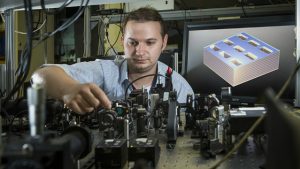
Thermophotovoltaic cells have the potential to be much more efficient than solar cells. Our metamaterial overcomes several obstacles and could help to unlock the potential of thermophotovoltaic cells.
The research is published in Nature Communications. The new metamaterial is made of nanoscopic structures of gold and magnesium fluoride. “The size of an individual building block of the metamaterial is so small that we could fit more than 12,000 of them on the cross-section of a human hair,” says Kruk. The material radiates heat in specific directions, and it can even be customized (with a slight change in geometry) to make it give off radiation in a specific range. It has an unusual way of glowing when it is heated. The technical term—magnetic hyperbolic dispersion, describes the material’s strong interactions with the magnetic component of light. These qualities make it suitable for use as an emitter for a TPV system that generates electricity in the dark.